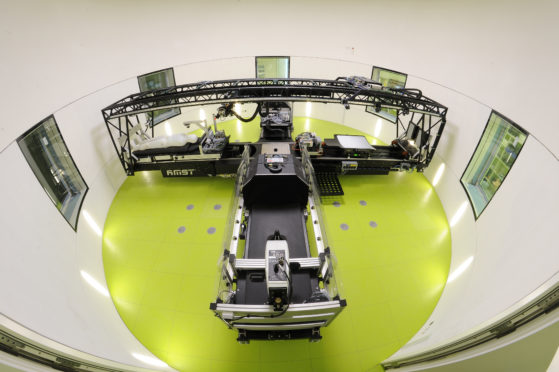
A new, space-influenced form of treatment is being tested in a move to help those facing long hospital stays or those suffering from lower back pain.
Patients will be safely spun in a ‘human centrifuge’ by researchers who hope to help maintain the size, quality and strength of muscles.
The UK Space Agency is supporting the research which could also benefit astronauts, who experience muscle loss in space, on board the International Space Station or on future missions to the Moon and Mars.
The reduced gravity in space makes it difficult for the human body to maintain muscle mass and bone density.
The project at Manchester Metropolitan University is led by Professor Hans Degens’ team from the research centre for Musculoskeletal Science and Sports Medicine.
The team will perform a series of medical tests on volunteers subjected to 60 days of bed-rest, which mimics the microgravity conditions of space travel.
But some will also spend 30 minutes each day strapped into the human centrifuge, where they lay flat as it spins, simulating the force of gravity experienced when standing on Earth.
Science Minister Chris Skidmore said: “By learning about how to tackle muscle wasting in astronauts who experience zero gravity in space, this pioneering research hopes to lessen the impact on future spaceflights, something which will be particularly important if we ever send humans on the long journey to Mars.
“It has benefits on Earth too, helping the thousands of patients who develop muscle weakness from lengthy stays in a hospital bed.”
“We will need to embrace new technology like this to meet the needs of our ageing society, which is why through our modern Industrial Strategy, this Government is giving the biggest boost to R&D funding in UK history.”
The UK’s ongoing membership of the European Space Agency (ESA) gives UK scientists, researchers and industry access to world-leading facilities and the opportunity to form international partnerships that can benefit our understanding of the universe and life on Earth.
The new research projects at Manchester Metropolitan University and Northumbria University are also supported by the ESA, NASA and German Aerospace Centre (DLR).
Professor Hans Degens said: “Artificial gravity could help astronauts to maintain muscle mass in space and help back here on Earth too by preventing severe muscle degeneration in hospitalised patients.
“Currently astronauts have to exercise for up to 2.5 hours every day, take nutrient supplements, and keep high protein diets to maintain muscle mass while they are in space. Despite this, severe muscle deterioration still occurs.
“One day, astronauts might have a daily quick spin in a centrifuge on the ISS rather than spend hours on gym equipment in space. For hospital patients it could greatly improve their recovery during rehabilitation and after they leave.”
The study will use the human centrifuge to explore the effectiveness of daily exposure to artificial gravity in preventing spinal problems from developing. It will also test the effectiveness of a rehabilitation device – which resembles a customised gym cross trainer and is known as the Functional Re-adaptive Exercise Device (FRED) – in the early weeks following the 60 day bed rest period.

Enjoy the convenience of having The Sunday Post delivered as a digital ePaper straight to your smartphone, tablet or computer.
Subscribe for only £5.49 a month and enjoy all the benefits of the printed paper as a digital replica.
Subscribe